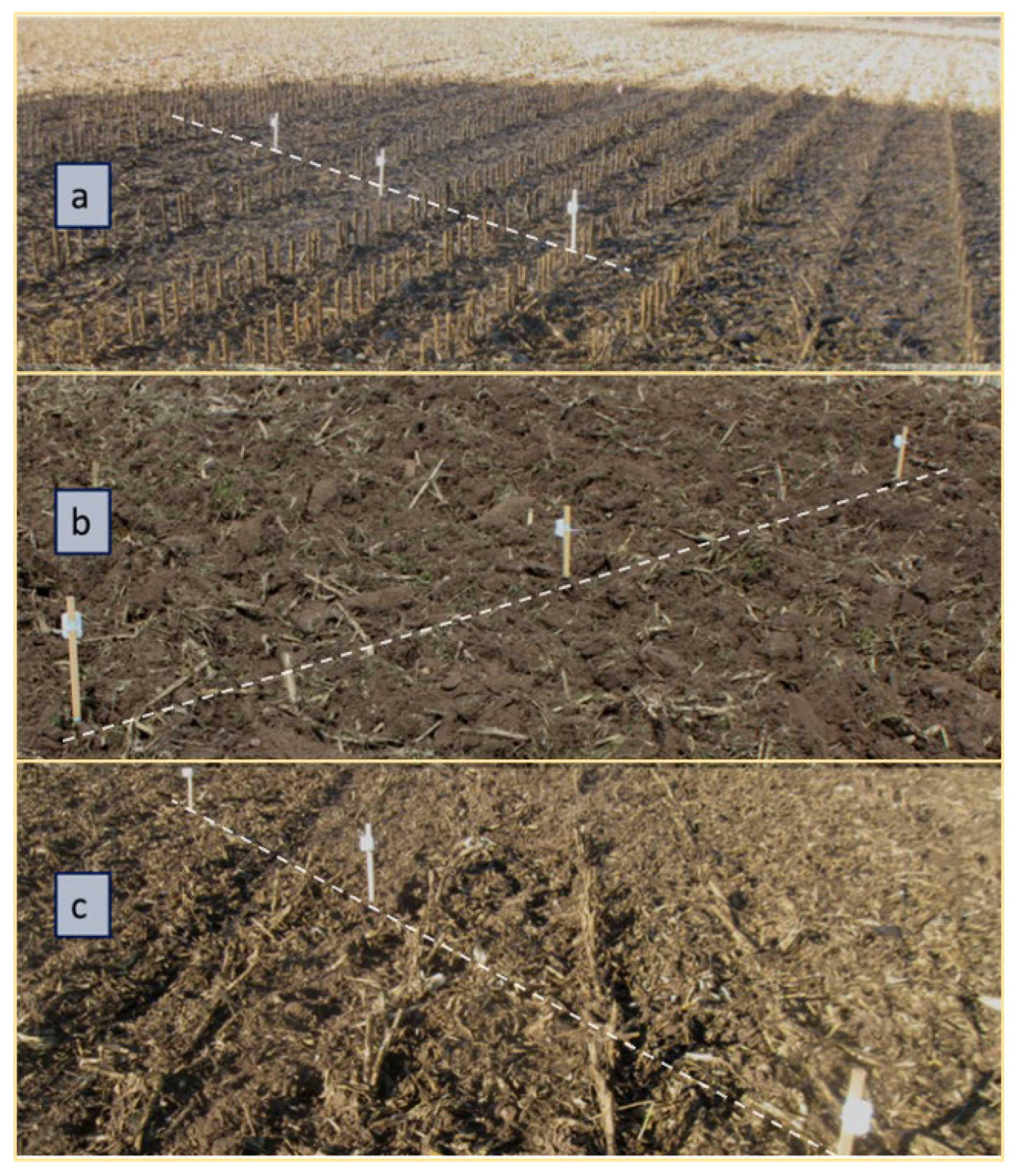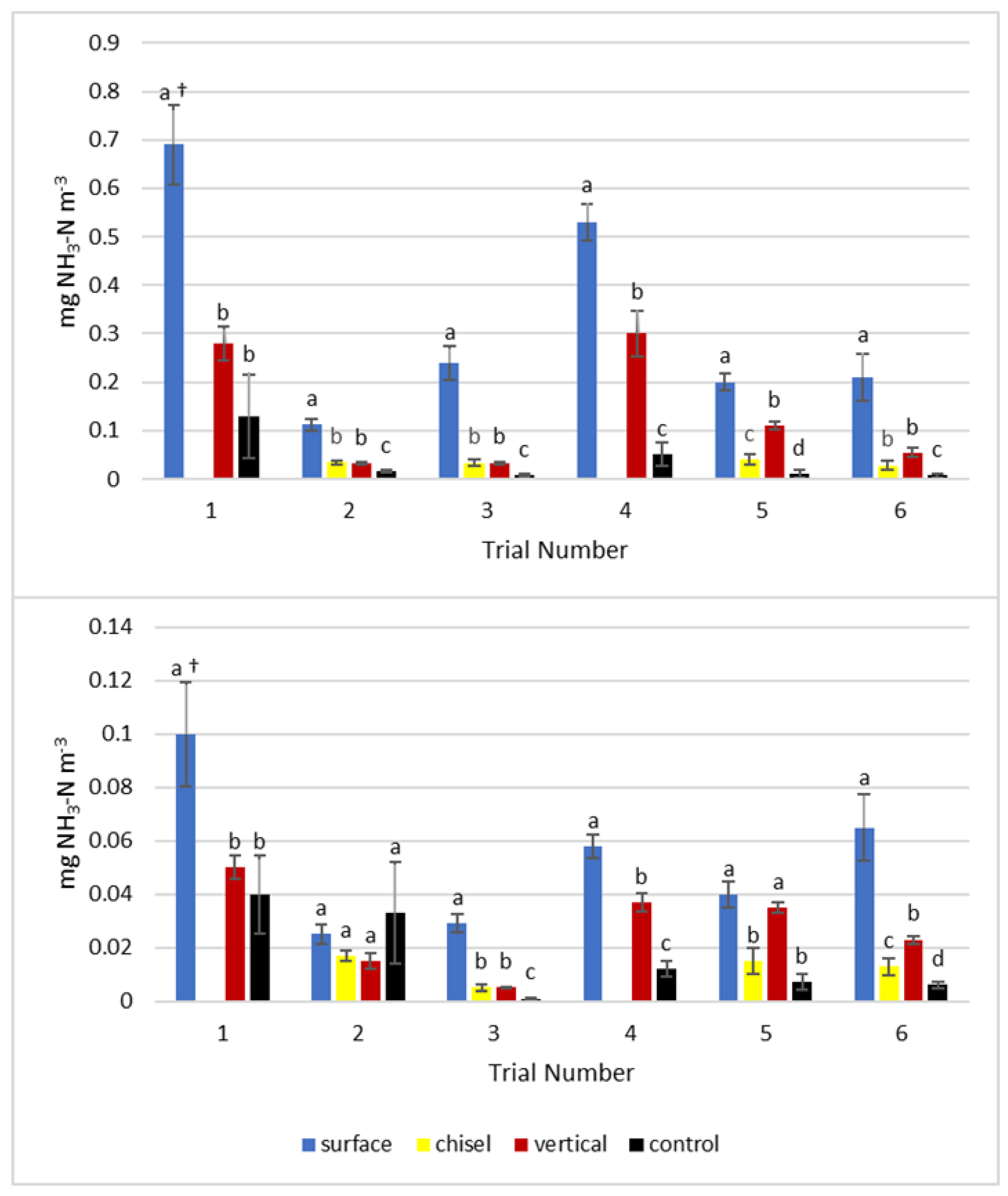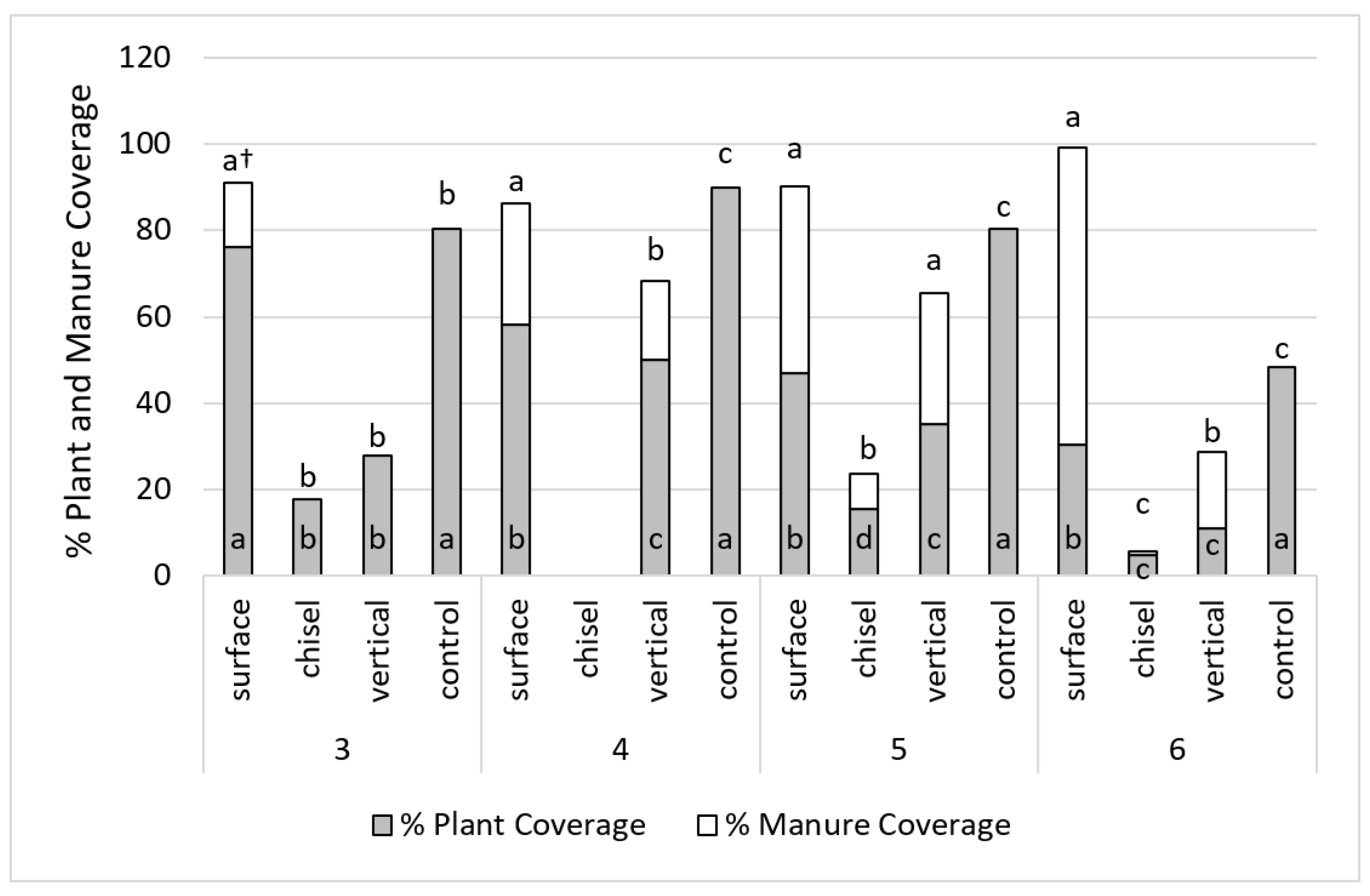Factors Influencing Ammonia Concentrations above Corn Fields after Dairy Manure Application
Abstract
1. Introduction
2. Materials and Methods
3. Results and Discussion
3.1. Manure and Soil Properties
3.2. Influence of Manure Incorporation on NH3-N Concentrations
3.3. Impact of Weather Conditions and Manure on NH3-N Concentrations
3.4. Impact of Crop Residue and Manure Coverage on NH3-N Concentrations
4. Conclusions
Author Contributions
Funding
Data Availability Statement
Acknowledgments
Conflicts of Interest
References
- Apsimon, H.M.; Kruse, M.; Bell, J.N.B. Ammonia emissions and their role in acid deposition. Atmos. Environ. 1987, 21, 1939–1946. [Google Scholar] [CrossRef]
- IPCC. Guidelines for National Greenhouse Gas Inventories; Agriculture, Forestry and Other Land Use; Intergovernmental Panel on Climate Change: Geneva, Switzerland, 2006; Volume 4. [Google Scholar]
- Renard, J.J.; Calidonna, S.E.; Henley, M.V. Fate of ammonia in the atmosphere—A review for applicability to hazardous he authors declare no conflict of interest releases. J. Hazard. Mater. 2004, 108, 29–60. [Google Scholar] [CrossRef] [PubMed]
- Webb, J.; Pain, B.; Bittman, S.; Morgan, J. The impacts of manure application methods on emissions of ammonia, nitrous oxide and on crop response—A review. Agric. Ecosyst. Environ. 2010, 137, 39–46. [Google Scholar] [CrossRef]
- Wulf, S.; Maeting, M.; Clemens, J. Application technique and slurry co-fermentation effects on ammonia, nitrous oxide, and methane emissions after spreading: II. Greenhouse gas emissions. J. Environ. Qual. 2002, 31, 1795–1801. [Google Scholar] [CrossRef] [PubMed]
- Huijsmans, J.F.M.; Hol, J.M.G.; Vermeulen, G.D. Effect of application method, manure characteristics, weather and field conditions on ammonia volatilization from manure applied to arable land. Atmos. Environ. 2003, 37, 3669–3680. [Google Scholar] [CrossRef]
- Leytem, A.B.; Bjorneberg, D.L.; Sheffield, R.E.; de Haro Marti, M.E. Case study: On-farm evaluation of liquid dairy manure application methods to reduce ammonia losses. Prof. Anim. Sci. 2009, 25, 93–98. [Google Scholar] [CrossRef]
- Powell, J.M.; Jokela, W.E.; Misselbrook, T.H. Dairy slurry application method impacts ammonia emission and nitrate leaching in no-till corn silage. J. Environ. Qual. 2011, 40, 388–392. [Google Scholar] [CrossRef]
- Dell, C.J.; Kleinman, P.J.A.; Schmidt, J.P.; Beegle, D.B. Low-disturbance manure incorporation effects on ammonia and nitrate loss. J. Environ. Qual. 2012, 41, 928–937. [Google Scholar] [CrossRef]
- Webb, J.; Thorman, R.E.; Fernanda-Aller, M.; Jackson, D.R. Emission factors for ammonia and nitrous oxide emissions following immediate manure incorporation on two contrasting soil types. Atmos. Environ. 2014, 82, 280–287. [Google Scholar] [CrossRef]
- Sherman, J.F.; Young, E.O.; Cavadini, J. Tillage and liquid dairy manure effects on overland flow nitrogen and phosphorus loss potential in an upper Midwest corn silage-winter triticale cropping system. Agronomy 2021, 11, 1775. [Google Scholar] [CrossRef]
- Sherman, J.F.; Young, E.O.; Jokela, W.E.; Cavadini, J. Impacts of low-disturbance dairy manure incorporation on ammonia and greenhouse gas fluxes in a corn silage–winter rye cover crop system. J. Environ. Qual. 2021, 50, 836–846. [Google Scholar] [CrossRef] [PubMed]
- Sherman, J.; Young, E.O.; Jokela, W.E.; Cavadini, J. Impacts of low disturbance liquid dairy manure incorporation on alfalfa yield and fluxes of ammonia, nitrous oxide, and methane. Agriculture 2021, 11, 750. [Google Scholar] [CrossRef]
- Pain, B.F.; Phillips, V.R.; Clarkson, C.R.; Klarenbeek, J.V. Loss of nitrogen through ammonia volatilisation during and following the application of pig or cattle slurry to grassland. J. Sci. Food Agric. 1989, 47, 1–12. [Google Scholar] [CrossRef]
- Thompson, R.B.; Pain, B.F.; Rees, Y.J. Ammonia volatilization from cattle slurry following surface application to grassland: II. Influence of application rate, wind speed and applying slurry in narrow bands. Plant Soil 1990, 125, 119–128. [Google Scholar] [CrossRef]
- Huijsmans, J.F.M.; Hol, J.M.G.; Hendriks, M.M.W.B. Effect of application technique, manure characteristics, weather and field conditions on ammonia volatilization from manure applied to grassland. Neth. J. Agric. Sci. 2001, 49, 323–342. [Google Scholar] [CrossRef]
- Hanna, H.M.; Bundy, D.S.; Lorimor, J.C.; Mickelson, S.K.; Melvin, S.W.; Erbach, D.C. Manure incorporation equipment effects on odor, residue cover, and crop yield. Appl. Eng. Agric. 2000, 16, 621–627. [Google Scholar] [CrossRef]
- Shelton, D.P. Crop residue cover and manure incorporation Part I: Reduction of percent cover. Appl. Eng. Agric. 2004, 20, 605–611. [Google Scholar] [CrossRef]
- Kovar, J.L.; Moorman, T.B.; Singer, J.W.; Cambardella, C.A.; Tomer, M.D. Swine manure injection with low-disturbance applicator and cover crops reduce phosphorus losses. J. Environ. Qual. 2011, 40, 329–336. [Google Scholar] [CrossRef]
- Frost, J.P. Effect of spreading method, application rate and dilution on ammonia volatilization from cattle slurry. Grass Forage Sci. 1994, 49, 391–400. [Google Scholar] [CrossRef]
- Sommer, S.G.; Hutchings, N.J. Ammonia emission from field applied manure and its reduction—Invited paper. Eur. J. Agron. 2001, 15, 1–15. [Google Scholar] [CrossRef]
- Brunke, R.P.; Schuepp, A.P.; Gordon, R. Effect of meteorological parameters on ammonia loss from manure in the field. J. Environ. Qual. 1988, 17, 431–436. [Google Scholar] [CrossRef]
- Sommer, S.G.; Olesen, J.E. Effects of dry matter content and temperature on ammonia loss from surface applied cattle slurry. J. Environ. Qual. 1991, 20, 679–683. [Google Scholar] [CrossRef]
- Sommer, S.G.; Olesen, J.E.; Christensen, B.T. Effects of temperature, wind speed and air humidity on ammonia volatilization from surface applied cattle slurry. J. Agric. Sci. 1991, 117, 91–100. [Google Scholar] [CrossRef]
- Moal, J.F.; Martinez, J.; Guiziou, F.; Coste, C.M. Ammonia volatilization following surface applied pig and cattle slurry in France. J. Agric. Sci. 1995, 125, 245–252. [Google Scholar] [CrossRef]
- CTIC. National Crop Residue Management Survey; Conservation Tillage Information Center: West Lafayette, IN, USA, 2016. [Google Scholar]
- Kern, J.S.; Johnson, M.G. Conservation tillage impacts on national soil and atmospheric carbon levels. Soil Sci. Soc. Am. J. 1993, 57, 200–210. [Google Scholar] [CrossRef]
- West, T.O.; Post, W.M. Soil organic carbon sequestration rates by tillage and crop rotation: A global data analysis. Soil Sci. Soc. Am. J. 2002, 66, 1930–1946. [Google Scholar] [CrossRef]
- Jacobs, A.; Rauber, R.; Ludwig, B. Impact of reduced tillage on carbon and nitrogen storage of two Haplic Luvisols after 40 years. Soil Till. Res. 2009, 102, 158–164. [Google Scholar] [CrossRef]
- Kushwaha, C.P.; Tripathi, C.P.; Singh, K.P. Soil organic matter and water-stable aggregates under different tillage and residue conditions in a tropical dryland agroecosystem. Appl. Soil Ecol. 2001, 16, 229–241. [Google Scholar] [CrossRef]
- Mueller, D.H.; Klemme, R.M.; Daniel, T.C. Short and long-term cost comparisons of conventional tillage systems in corn production. J. Soil Water Conserv. 1985, 40, 466–470. [Google Scholar]
- Schuler, R.T. Residue Management-Horizontal vs. Vertical Tillage. In Wisconsin Fertilizer, Aglime and Pest Management Conference; University of Wisconsin Extension: Madison, WI, USA, 2007; Volume 46, pp. 179–181. [Google Scholar]
- Klingsberg, K.; Weisenbeck, C. Shallow vertical tillage: Impact on soil disturbance and crop residue. In Wisconsin Crop Management Conference; University of Wisconsin: Madison, WI, USA, 2011; Volume 50, pp. 46–49. [Google Scholar]
- Peters, J. Recommended Methods of Manure Analysis; Extension, Ed.; University of Wisconsin: Madison, WI, USA, 2003. [Google Scholar]
- Schulte, E.E.; Hopkins, B.G. Estimation of soil organic matter by weight 3. Organic matter (LOI) loss-on-ignition. In Soil Organic Matter: Analysis and Interpretation; Magdoff, F.R., Tabatabai, M.A., Hanlon, E.A., Jr., Eds.; Soil Science Society of America, Inc.: Madison, WI, USA, 1996; pp. 21–31. [Google Scholar]
- Lachat Instruments. Determination of Ammonia (Salicylate) in 2M KCl Soil Extracts by Flow Injection Analysis; QuikChem Method 12-107-06-2-A.; Lachat Instruments: Loveland, CO, USA, 1993. [Google Scholar]
- Booth, D.T.; Cox, S.E.; Berryman, R.D. Point sampling digital imagery with SamplePoint. Environ. Monit. Assess. 2006, 123, 97–108. [Google Scholar] [CrossRef]
- Roadman, M.J.; Scudlark, J.R.; Meisinger, J.J.; Ullman, W.J. Validation of Ogawa passive samplers for the determinations of gaseous ammonia concentrations in agricultural settings. Atmos. Environ. 2003, 37, 2317–2325. [Google Scholar] [CrossRef]
- Lachat Instruments. Determination of Ammonia by Flow Injection Analysis; QuikChem Method 10-107-06-2-A.; Lachat Instruments: Loveland, CO, USA, 2003. [Google Scholar]
- SAS Institute Inc. SAS 9.4 Guide to Software Updates; SAS Institute Inc.: Cary, NC, USA, 2013. [Google Scholar]
- Scudlark, J.R.; Jennings, J.A.; Roadman, M.J.; Savidge, K.B.; Ullman, W.J. Atmospheric nitrogen inputs to the Delaware inland bays: The role of ammonia. Environ. Pollut. 2005, 135, 433–444. [Google Scholar] [CrossRef] [PubMed]
- Pleim, J.E.; Ran, L.; Appel, W.; Shephard, M.W.; Cady-Pereira, K. New bidirectional ammonia flux model in an air quality model coupled with an agricultural model. J. Adv. Model. Earth Syst. 2019, 11, 2934–2957. [Google Scholar] [CrossRef]
- Zhang, T.; Liu, H.; Luo, J.; Wang, H.; Zhai, L.; Geng, Y.; Zhang, Y.; Li, J.; Lei, Q.; Bashir, M.A.; et al. Long-term manure application increased greenhouse gas emissions but had no effect on ammonia volatilization in a Northern China upland field. Sci. Total Environ. 2018, 633, 230–239. [Google Scholar] [CrossRef] [PubMed]
- Ramanantenasoa, M.M.J.; Génermont, S.; Gilliot, J.-M.; Bedos, C.; Makowski, D. Meta-modeling methods for estimating ammonia volatilization from nitrogen fertilizer and manure applications. J. Environ. Manag. 2019, 236, 195–205. [Google Scholar] [CrossRef]
- Miola, E.C.C.; Aita, C.; Rochette, P.; Chantigny, M.H.; Angers, D.A.; Bertrand, N.; Gasser, M.O. Static chamber measurements of ammonia volatilization from manured soils: Impact of deployment duration and manure characteristics. Soil Sci. Soc. Am. J. 2014, 79, 305–313. [Google Scholar] [CrossRef]
- Lorimor, J.; Powers, W.; Sutton, A. Manure Characteristics, 2nd ed.; MWPS-18 Section 1; Manure Management System Series; Michigan State University Extension: East Lansing, MI, USA, 2006. [Google Scholar]
- Ramanantenasoa, M.M.J.; Gilliot, J.M.; Mignolet, C.; Bedos, C.; Mathias, E.; Eglin, T.; Makowski, D.; Génermont, S. A new framework to estimate spatio-temporal ammonia emissions due to nitrogen fertilization in France. Sci. Total Environ. 2018, 645, 205–219. [Google Scholar] [CrossRef]



| Treatments | ||||||||
|---|---|---|---|---|---|---|---|---|
| Trial | Date | Control | Surface | Chisel | Case IH 330 | Great Plains Turbo Max 1800 | Residue | Manure Type |
| 1 | 25 September 2013 | X | X | X | Silage Corn | Solid Pack | ||
| 2 | 2 July 2014 | X | X | X | X | Oats | Separated Liquid | |
| 3 | 11 August 2015 | X | X | X | X | Oats | Unagitated Separated Liquid | |
| 4 | 4 November 2015 | X | X | X | Grain Corn | Whole Dairy Slurry | ||
| 5 | 3 May 2016 | X | X | X | X | Grain Corn | Whole Dairy Slurry | |
| 6 | 17 May 2016 | X | X | X | X | Silage Corn | Whole Dairy Slurry | |
| Trial | Date | DM † | TN | TP | NH4-N | pH | Rate ‡ | TN | TP | NH4-N |
|---|---|---|---|---|---|---|---|---|---|---|
| % | Mg ha−1 | kg ha−1 | ||||||||
| 1 | 25 September 2013 | 29 ± 0.9 †‡ | 1.8 ± 0.06 | 0.34 ± 0.04 | 0.4 ± 0.1 | 8.3 ± 0.12 | 95.3 | 484 | 91 | 94 |
| 2 | 2 July 2014 | 1.5 ± 0.05 | 6.8 ± 0.20 | 1.09 ± 0.00 | 4.5 ± 0.2 | 7.6 ± 0.05 | 53.6 | 82 | 13 | 54 |
| 3 | 11 August 2015 | 5.1 ± 0.1 | 3.3 ± 0.05 | 0.65 ± 0.03 | 1.3 ± 0.0 | 8.2 ± 0.08 | 83.9 | 137 | 28 | 55 |
| 4 | 4 November 2015 | 22 ± 1.8 | 1.6 ± 0.15 | 0.30 ± 0.00 | 0.7 ± 0.1 | 8.1 ± 0.05 | 110 | 412 | 80 | 185 |
| 5 | 3 May 2016 | 8.7 ± 0.60 | 3.1 ± 0.25 | 0.74 ± 0.00 | 1.5 ± 0.1 | 7.8 ± 0.10 | 69.6 | 181 | 44 | 89 |
| 6 | 17 May 2016 | 6.5 ± 0.1 | 3.1 ± 0.08 | 0.79 ± 0.01 | 1.3 ± 0.05 | 7.8 ± 0.20 | 90.9 | 180 | 46 | 74 |
| Trial | Date | pH | NH4-N † | Moisture | OM ‡ |
|---|---|---|---|---|---|
| mg kg−1 | g kg−1 | ||||
| 1 | 25 September 2013 | 7.2 ± 0.05 ‡† | †‡ | 184 ± 2.4 | 27 ± 1.7 |
| 2 | 2 July 2014 | 7.0 ± 0.16 | 3.7 ± 1.5 | 329 ± 26 | 32 ± 1.4 |
| 3 | 11 August 2015 | 7.0 ± 0.08 | 3.2 ± 0.8 | 317 ± 17 | 30 ± 3.4 |
| 4 | 4 November 2015 | 6.3 ± 0.20 | 2.6 ± 0.8 | 346 ± 19 | 30 ± 0.5 |
| 5 | 3 May 2016 | 6.8 ± 0.12 | 3.4 ± 0.2 | 401 ± 38 | 33 ± 0.8 |
| 6 | 17 May 2016 | 6.7 ± 0.05 | 3.7 ± 1.2 | 289 ± 6.2 | 35 ± 0.5 |
| Trial | Date | Relative Humidity | Temperature | Total Rainfall | Wind Speed | Wind Gusts |
|---|---|---|---|---|---|---|
| % | °C | mm | m s−1 | |||
| 1 | 25 September 2013 | 89 | 14 | 0.0 | 2.6 | 7.4 |
| 2 | 2 July 2014 | 60 | 16 | 0.0 | 1.3 | 3.2 |
| 3 | 11 August 2015 | 73 | 20 | 0.0 | 0.9 | 2.3 |
| 4 | 4 November 2015 | 85 | 14 | 8.4 | 2.8 | 5.2 |
| 5 | 3 May 2016 | 62 | 9 | 7.1 | 2.0 | 4.2 |
| 6 | 17 May 2016 | 52 | 11 | 1.3 | 0.4 | 1.7 |
| Pearson Correlation Coefficients | ||||||
| first 24 h | 0.55 ** | −0.51 | 0.13 | 0.49 * | 0.56 ** | |
| second 24 h | 0.39 | −0.27 | 0.10 | 0.43 * | 0.55 ** | |
Disclaimer/Publisher’s Note: The statements, opinions and data contained in all publications are solely those of the individual author(s) and contributor(s) and not of MDPI and/or the editor(s). MDPI and/or the editor(s) disclaim responsibility for any injury to people or property resulting from any ideas, methods, instructions or products referred to in the content. |
© 2023 by the authors. Licensee MDPI, Basel, Switzerland. This article is an open access article distributed under the terms and conditions of the Creative Commons Attribution (CC BY) license (https://creativecommons.org/licenses/by/4.0/).
Share and Cite
Sherman, J.F.; Young, E.O.; Jokela, W.E. Factors Influencing Ammonia Concentrations above Corn Fields after Dairy Manure Application. Environments 2023, 10, 140. https://doi.org/10.3390/environments10080140
Sherman JF, Young EO, Jokela WE. Factors Influencing Ammonia Concentrations above Corn Fields after Dairy Manure Application. Environments. 2023; 10(8):140. https://doi.org/10.3390/environments10080140
Chicago/Turabian StyleSherman, Jessica F., Eric O. Young, and William E. Jokela. 2023. "Factors Influencing Ammonia Concentrations above Corn Fields after Dairy Manure Application" Environments 10, no. 8: 140. https://doi.org/10.3390/environments10080140
APA StyleSherman, J. F., Young, E. O., & Jokela, W. E. (2023). Factors Influencing Ammonia Concentrations above Corn Fields after Dairy Manure Application. Environments, 10(8), 140. https://doi.org/10.3390/environments10080140







